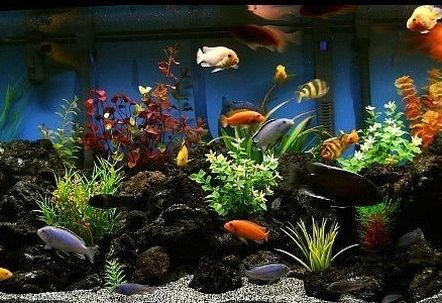Creating a great looking aquascape requires a mix of skills. Many professional aquascapers like Josh Sim from Malaysia and others use the principles of depth, perspective and rock arrangement to create their scapes.
Substrate layering provides stability and supports plant growth. Choose the right substrate based on aesthetics and the light requirements of your plants.
Aquarium Layout Planning
The first step in aquascaping is planning the layout of the aquarium. The aquarist chooses a theme to portray and arrange the hardscape, plants, and fish according to that theme. The theme should also be reflected in the choice of substrate.
There are many ways to plan a tank layout, and each aquarist has their own personal favorite. However, there are some basic guidelines that are useful. For instance, a good rule of thumb is to make the tank’s negative space (space not covered by planting or hardscape) two thirds of its total surface area. This will help create a sense of depth.
Another important concept is utilizing contrast. This is accomplished by varying the size, shape, and color of the various elements in the aquarium. This helps create a sense of depth and draws the viewer’s eye throughout the scene. Focal points, such as a large piece of driftwood or unusually shaped rock, are used to draw the viewer’s attention and act as an anchor for the entire aquarium layout. By following these simple rules, aquarists can create a stunning aquarium that will take the viewer into a mesmerizing underwater world.

Substrate
The material that lines the bottom of a fish tank is called substrate and can have a significant effect on plant growth and aquarium aesthetics. There are many different options available, from brightly colored substrate to match a castle or mermaid theme for children’s aquariums, to more natural brown gravel that blends in with the driftwood and aquatic plants. When choosing a substrate for your aquascape it is important to consider particle size, color, reactivity with the water and effect on your fish.
Generally speaking, you want to choose a substrate that is not too thick. Thick substrate can limit the growth of your plants, can clog filters and be difficult to clean. The color of the substrate is also a personal preference. Bright substrate colors will make light-colored fish stand out, but can spook some fish. A dark substrate will help to accentuate the color of your fish and may be best for darker fish. It is also possible to make a “decreasing in size” arrangement of the substrate, scaping the focal point rocks and driftwood with larger material, then using smaller gravel for the rest of the substrate.
Aquatic Plants
Aquatic plants give the aquarium a natural look and also provide oxygen and absorb ammonia, which benefits fish and invertebrates. They also offer valuable shelter and spawning sites for many fish species. In addition, they help control algae growth and stabilize pH levels of the tank water.
The best way to select the right aquatic plant for your tank is to visit a reputable aquarium store that stocks live plants. Be sure to avoid stores that sell non-aquatic plants from their aquatic department, as these will not thrive in the aquarium environment and will likely die over time.
There are a number of aquatic plants available to the hobbyist, including stem, moss and carpeting species. Many of these are derived from tissue culture, making them a relatively disease-free option for the beginner aquarist. Some of the most popular include dwarf hairgrass (Eleocharis spp), swordgrass (Eleocharis heteranthera) and the riccia species made famous by Takashi Amano. These plants are suitable for freshwater or saltwater aquariums and can be grown emersed or submerged, depending on their preference.
Rock and Driftwood Placement
The use of rocks and driftwood is a vital part of the aquascape. They help to create an environment that feels natural and creates layers for the aquarium. These natural elements also allow you to create focal points in your aquarium that catch the eye. Focal points can be anything from a big piece of driftwood to a unique rock formation or shadowing.
Driftwood should be carefully placed in your aquascape to ensure that it doesn’t leach tannins into the aquarium water, which can harm aquatic plants. Driftwood should also be sized appropriately for the tank. Larger pieces of driftwood will be more prominent and add height to the tank while smaller pieces will be used to fill in gaps and provide visual interest.
For example, a large piece of driftwood can be used to create a cliff or mountain in your aquascape while a small piece of driftwood can be used for a cave. In addition to this, the use of color contrasts is important for creating depth in an aquascape. For example, using a mixture of large and small rocks as well as varying colors will make your aquarium look more natural.
Aquarium Water Chemistry and Filtration
The final step in aquascaping is maintaining the lap dat be ca theo yeu cau aquarium’s water quality and chemical balance. This requires frequent water changing and plant-trimming as well as accurate balancing of light, CO2, and nutrients. Achieving this requires the use of various filter media including carbon, GFO, and synthetic polymers that adsorb particular dissolved contaminants.
Layering is an important aquascaping technique that creates depth and perspective in the aquarium. For this reason, it’s important to use a variety of plants in the foreground, midground, and background. This adds authenticity and appeal to the scene, allowing the viewer to immerse themselves in the aquarium’s landscape.
The rule of thirds is a simple but effective way to achieve this. It involves using an imaginary grid made of two horizontal and two vertical lines over the aquarium’s surface to divide it into nine equal sections. Creating focal points along these lines or at the places where they intersect will help you avoid symmetry and ensure that your aquarium is interesting and dynamic.
